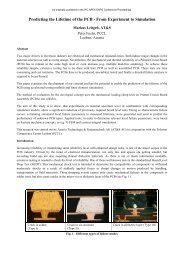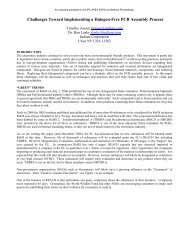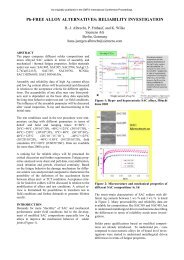Moisture Measurements in PCBs and Impact of Design ... - IPC Outlook
Moisture Measurements in PCBs and Impact of Design ... - IPC Outlook
Moisture Measurements in PCBs and Impact of Design ... - IPC Outlook
Create successful ePaper yourself
Turn your PDF publications into a flip-book with our unique Google optimized e-Paper software.
As orig<strong>in</strong>ally published <strong>in</strong> the <strong>IPC</strong> APEX EXPO Conference Proceed<strong>in</strong>gs.Figure 6 Modelled moisture pr<strong>of</strong>ile over hole cross section after 1, 12, 24, 48, 100 <strong>and</strong> 150 hours for (a) non-PTH withcopper plane on outer layers, (b) PTH with copper plane on outer layers <strong>and</strong> (c) PTH with <strong>in</strong>ternal copper planesThe moisture exits the non-PTH PCB model much more quickly because moisture can escape more easily from the greateropen surface area which is 1.26 mm 2 for the PTH <strong>and</strong> 4.02 mm 2 for the non-PTH. For a PTH board, the rate <strong>of</strong> moisture lossis much slower, because moisture must diffuse a greater distance to f<strong>in</strong>d a surface free from copper before it can exit theboard. The mean moisture content <strong>of</strong> the central 1 mm core <strong>of</strong> a PTH <strong>and</strong> non-PTH PCB is plotted <strong>in</strong> Figure 7. It takes 17hours to halve the <strong>in</strong>ternal moisture with<strong>in</strong> the 4 mm pitch non-PTH board; the time <strong>in</strong>creases to 27 hours for the PCB withPTH holes. For the board with <strong>in</strong>ternal copper planes (Figure 5c), the moisture rapidly exits from the external layers abovethe copper planes, but takes 49 hours to halve the moisture level between the copper planes. This is ma<strong>in</strong>ly due to thedecrease <strong>in</strong> area from which the moisture can escape as the gap with<strong>in</strong> the copper planes is smaller (the clearance distance isstill 0.2 mm between PTH <strong>and</strong> copper plane, but as the copper plane open area now has a smaller radius due to no l<strong>and</strong>, thegap area has decreased by 40%, 0.63 to 0.38mm²). This is illustrated <strong>in</strong> Figure 8.
As orig<strong>in</strong>ally published <strong>in</strong> the <strong>IPC</strong> APEX EXPO Conference Proceed<strong>in</strong>gs.Figure 7 Modelled effect <strong>of</strong> bake time on the mean moisture content <strong>in</strong> the central region (1 mm <strong>of</strong>f the copper plane)<strong>in</strong> boards PTH <strong>and</strong> non-PTH boards.Figure 8 Diagram show<strong>in</strong>g relative plane to hole clearances (open areas for moisture diffusion) for (left) non-PTHwith copper plane on outer layers, (centre) PTH with copper plane on outer layers <strong>and</strong> (right) PTH with <strong>in</strong>ternalcopper planesWhilst there is a difference <strong>in</strong> the bake times for PTH <strong>and</strong> non-PTH, this difference is relatively small compared to the effect<strong>of</strong> the hole density, which has been reported elsewhere [8] <strong>and</strong> can also be appreciated by consider<strong>in</strong>g the hole density <strong>in</strong> ameshed copper plane.Modell<strong>in</strong>g desorption <strong>in</strong> meshed copper planesMeshed copper planes can provide improved bond<strong>in</strong>g between adjacent epoxy layers, thus <strong>in</strong>creas<strong>in</strong>g strength <strong>and</strong> alsoprovide a shorter route for moisture to diffuse more quickly <strong>in</strong>to <strong>and</strong> out <strong>of</strong> the board. However, meshed copper planes maydegrade electrical performance. A model was created to illustrate the effectiveness <strong>of</strong> mesh<strong>in</strong>g a copper plane on the surface<strong>of</strong> a double-sided PCB, (see Figure 9). The PCB was <strong>in</strong>itially set to be saturated with moisture, the external surface was set tobe dry, <strong>and</strong> moisture was allowed to escape with a diffusion coefficient <strong>of</strong> 33 µm 2 s -1 (to simulate bak<strong>in</strong>g FR-4 material at125°C). Figure 10 displays the moisture pr<strong>of</strong>ile at a depth <strong>of</strong> 0.6 mm after 6, 15, 25 <strong>and</strong> 45 hours. As expected the moisturecontent decreases as it diffuses out <strong>of</strong> the board.
As orig<strong>in</strong>ally published <strong>in</strong> the <strong>IPC</strong> APEX EXPO Conference Proceed<strong>in</strong>gs.Figure 9 Model used to illustrate the effect <strong>of</strong> meshed copper planes consist<strong>in</strong>g <strong>of</strong> areas with (A) no mesh<strong>in</strong>g, (B) 56 %open area, (C) 25% open area <strong>and</strong> (D) solid copper plane.Figure 10 Contour plot show<strong>in</strong>g the percentage <strong>of</strong> <strong>in</strong>itial moisture <strong>in</strong>side the PCB at a depth <strong>of</strong> 0.6 mm after 6, 15, 25<strong>and</strong> 45 hours <strong>of</strong> bak<strong>in</strong>g at 125°C.
As orig<strong>in</strong>ally published <strong>in</strong> the <strong>IPC</strong> APEX EXPO Conference Proceed<strong>in</strong>gs.Figure 12 Illustration <strong>of</strong> modelled surface copper plane, moisture pr<strong>of</strong>ile after 120 days at 20°C, <strong>and</strong> moisture pr<strong>of</strong>ileafter bak<strong>in</strong>g at 125°C for 8, 24 <strong>and</strong> 72 hours.Whilst the moisture readily comes out at the edges <strong>of</strong> the copper plane, further <strong>in</strong>side the moisture is still diffus<strong>in</strong>g towardsthe centre <strong>of</strong> the copper plane, but now at a much faster rate than it entered the PCB, due to the much greater diffusioncoefficient at the higher bake temperature. The moisture at the centre therefore <strong>in</strong>creases, reach<strong>in</strong>g moisture contentcorrespond<strong>in</strong>g to 19.6% <strong>of</strong> the 20°C saturation condition after 40 hours as shown by Figure 13 before decreas<strong>in</strong>g.Figure 13 Average moisture content under copper plane, moisture content at centre <strong>and</strong> at the corner <strong>of</strong> the copperplanes throughout the soak <strong>and</strong> bake <strong>of</strong> the 12 mm square copper plane model.The saturation moisture concentration <strong>in</strong> air at 10°C is 0.009 kg m -3 whilst at 30°C this becomes 0.030 kg m -3 . The moistureconcentration also varies l<strong>in</strong>early with the humidity up to the saturation concentration. Therefore, the amount <strong>of</strong> moisture
As orig<strong>in</strong>ally published <strong>in</strong> the <strong>IPC</strong> APEX EXPO Conference Proceed<strong>in</strong>gs.that can diffuse <strong>in</strong>to a PCB will be largely dependent on the storage conditions, with cooler <strong>and</strong> dryer storage conditionsbe<strong>in</strong>g preferred. Under constant humidity conditions, the moisture from the ambient will <strong>in</strong> time extend <strong>in</strong>to the PCB withthe f<strong>in</strong>al saturation concentration be<strong>in</strong>g dependent on the PCB moisture uptake capability.ConclusionsCopper planes have a significant effect on moisture desorption <strong>and</strong> hence consideration to their design should be given tobake out requirements. Increas<strong>in</strong>g the bake time, whilst remov<strong>in</strong>g more moisture <strong>and</strong> reduc<strong>in</strong>g the delam<strong>in</strong>ation risk, can havedetrimental effects to the solderability <strong>and</strong> mechanical properties <strong>of</strong> the PCB, such that a compromise <strong>in</strong> bake time should besought. In many cases, when moisture has diffused under copper planes, it is not feasible to remove the moisture. Hencepreventative measures are required to stop moisture enter<strong>in</strong>g the PCB <strong>in</strong> the first place.The removal <strong>of</strong> moisture may not be straight forward, as was shown for two equal 12 mm square copper planes where <strong>in</strong> thecentral region the moisture <strong>in</strong>itially <strong>in</strong>creased dur<strong>in</strong>g bake out, as the moisture <strong>in</strong>itially equilibriates before diffus<strong>in</strong>g out <strong>of</strong>the board. If such moisture <strong>in</strong>creases are <strong>in</strong>to a delam<strong>in</strong>ation prone region, it is conceivable that bak<strong>in</strong>g may <strong>in</strong> some caseshave an unwanted effect <strong>of</strong> <strong>in</strong>creas<strong>in</strong>g delam<strong>in</strong>ation risk.Modell<strong>in</strong>g has shown that meshed copper planes can significantly reduce bake out times, with a clear functional dependenceon the open area <strong>of</strong> the mesh.AcknowledgementsThis work was supported under the framework <strong>of</strong> Jo<strong>in</strong>t Industry Projects, part <strong>of</strong> the Materials Measurement Programmesponsored by the National Measurement System unit <strong>of</strong> the UK’s Department for Bus<strong>in</strong>ess, Innovation <strong>and</strong> Skills. Theauthors wish to acknowledge the support <strong>and</strong> assistance to the project provided by the follow<strong>in</strong>g companies:Aero Eng<strong>in</strong>e ControlsArtetch Circuits LimitedBAE SystemsEuropean Space Research <strong>and</strong> Technology CentreGE Fanuc Intelligent PlatformsMBDA (UK) Ltd.Polar Instruments Europe Ltd.Rolls-Royce Mar<strong>in</strong>eSelex Galileo UKReferences1. N.P. Avdelidis, P. I. Nicholson & P. Wallace, ”Pulsed thermography <strong>in</strong> the <strong>in</strong>vestigation <strong>of</strong> <strong>PCBs</strong> for defectdetection & analysis”, Paper presented at 8th International Conference on Quantitative InfraRed Thermography,Padova, Italy, June 2006.2. E.H. Wong, Y.C. Teo, T.B Lim, “<strong>Moisture</strong> diffusion <strong>and</strong> vapour pressure modell<strong>in</strong>g <strong>of</strong> IC packag<strong>in</strong>g”, Proceed<strong>in</strong>gs<strong>of</strong> 48th Electronic Components <strong>and</strong> Technology Conference, pp1372-1378, May 1998.3. B. Xie, X.J. Fan, X.Q. Shi, H. D<strong>in</strong>g, “Direct Concentration Approach <strong>of</strong> <strong>Moisture</strong> Diffusion <strong>and</strong> Whole-Field VaporPressure Modell<strong>in</strong>g for Reflow Process- Part 1: Theory <strong>and</strong> Numerical Implementation”, J. Electron. Packag.131(3), Sept 2009.4. Y.C. L<strong>in</strong>, X. Chen, “Investigation <strong>of</strong> moisture diffusion <strong>in</strong> epoxy system: Experiments <strong>and</strong> molecular dynamicssimulations”, Chemical Physics Letters 412, pp 322-326, 20055. K. Weide-Zaage, W. Horaud, H. Frémont, “<strong>Moisture</strong> diffusion <strong>in</strong> pr<strong>in</strong>ted circuit boards: Measurement <strong>and</strong> f<strong>in</strong>iteelementsimulations”, Microelectron. Reliab. 45(9-11), pp1662-1667, 20056. <strong>IPC</strong>-1601, Pr<strong>in</strong>ted Board H<strong>and</strong>l<strong>in</strong>g <strong>and</strong> Storage Guidel<strong>in</strong>es, Draft March 2010.7. C. Hunt, M. Wickham, O. Thomas, L. Zou, “Assessment <strong>of</strong> <strong>Moisture</strong> Content Measurement Methods for Pr<strong>in</strong>tedCircuit Boards”, <strong>IPC</strong> International Conference for Electronics Board <strong>Design</strong> <strong>and</strong> Manufacture <strong>and</strong> Assembly, April2010.8. O. Thomas, C. Hunt & M. Wickham, “F<strong>in</strong>ite Difference Modell<strong>in</strong>g <strong>of</strong> <strong>Moisture</strong> Diffusion <strong>in</strong> Pr<strong>in</strong>ted Circuit Boardswith Copper Planes”, In Press
















